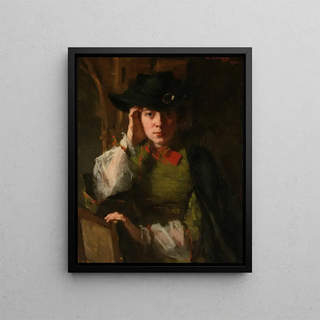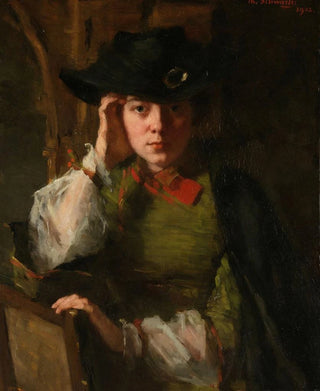Art print | Portrait of Lizzy Ansingh - Thérèse Schwartze


View from behind

Frame (optional)
The "Portrait of Lizzy Ansingh" by Thérèse Schwartze is a work that transcends the simple act of representation. This painting, created at the end of the 19th century, immerses us in a universe where beauty and intimacy meet. Lizzy's gaze, captured with such finesse, seems to tell a story, a life full of promises and secrets. This portrait is not just an image; it is an open window into the soul of its subject, an invitation to explore the emotions hidden behind each brushstroke. Contemplating this artwork, the viewer is transported to an era when art was a deeply personal means of expression, and every detail mattered.
Style and uniqueness of the work
The uniqueness of the "Portrait of Lizzy Ansingh" lies in the perfect harmony between Thérèse Schwartze's mastered technique and her model's vibrant personality. The artist uses a palette of delicate colors, blending warm and cool tones to create an atmosphere that is both soothing and captivating. The play of light and shadow adds an almost sculptural dimension to Lizzy's figure, highlighting her natural elegance. This portrait also stands out for its psychological approach, where the young woman's gaze seems to challenge the viewer, inviting reflection on her thoughts and emotions. Schwartze, as a female artist in a male-dominated world, successfully asserted her unique style, making each work an expression of her sensitivity and intelligence.
The artist and her influence
Thérèse Schwartze, an emblematic figure of Dutch painting, managed to establish herself in an artistic environment often reserved for men. Born in 1851, she developed a style that is uniquely her own, blending realism and intimacy. Her passion for portraiture led her to immortalize many personalities of her time, but she excels particularly in the representation of women. Schwartze was able to capture not only the appearance of her models but also their essence, their character. Her influence is felt in the art world, where she paved the way for

Matte finish

View from behind

Frame (optional)
The "Portrait of Lizzy Ansingh" by Thérèse Schwartze is a work that transcends the simple act of representation. This painting, created at the end of the 19th century, immerses us in a universe where beauty and intimacy meet. Lizzy's gaze, captured with such finesse, seems to tell a story, a life full of promises and secrets. This portrait is not just an image; it is an open window into the soul of its subject, an invitation to explore the emotions hidden behind each brushstroke. Contemplating this artwork, the viewer is transported to an era when art was a deeply personal means of expression, and every detail mattered.
Style and uniqueness of the work
The uniqueness of the "Portrait of Lizzy Ansingh" lies in the perfect harmony between Thérèse Schwartze's mastered technique and her model's vibrant personality. The artist uses a palette of delicate colors, blending warm and cool tones to create an atmosphere that is both soothing and captivating. The play of light and shadow adds an almost sculptural dimension to Lizzy's figure, highlighting her natural elegance. This portrait also stands out for its psychological approach, where the young woman's gaze seems to challenge the viewer, inviting reflection on her thoughts and emotions. Schwartze, as a female artist in a male-dominated world, successfully asserted her unique style, making each work an expression of her sensitivity and intelligence.
The artist and her influence
Thérèse Schwartze, an emblematic figure of Dutch painting, managed to establish herself in an artistic environment often reserved for men. Born in 1851, she developed a style that is uniquely her own, blending realism and intimacy. Her passion for portraiture led her to immortalize many personalities of her time, but she excels particularly in the representation of women. Schwartze was able to capture not only the appearance of her models but also their essence, their character. Her influence is felt in the art world, where she paved the way for






